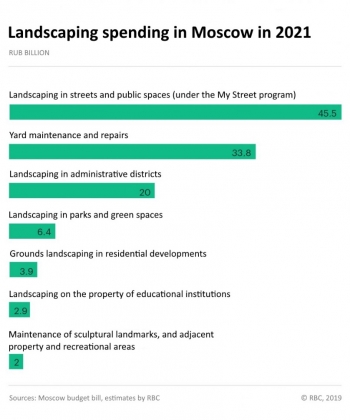Moscow’s estimated budget for the My Street program allows for RUB 45.5 billion in 2021, a record-breaking amount since its inception. “This is the largest landscaping and improvement project in Moscow’s modern history,” a source in the Mayor’s office commented.
According to the estimated Moscow budget for 2020 through 2022, RUB 107.2 billion is earmarked for the My Street program, of which RUB 45.5 billion falls within 2021. It is the largest annual amount since the program’s inception in 2015.
The previous spending record for the program was set in 2017, when RUB 42.2 billion was spent on My Street. According to the budget performance bill, RUB 27.6 billion was allocated to the program and around 80 landscaping projects were implemented in 2018, mainly in the city’s bedroom communities (downtown projects were completed as part of preparing for the soccer world cup). From 2018 to 2020, the city is expected to spend RUB 71 billion on My Street.
RUB 177.4 billion is allocated in the Moscow budget for the subprogram Grounds Maintenance and Landscaping in Residential Developments and Other Activities in the Housing Sector for 2020 to 2022.According to RBC’s estimates, RUB 112 billion will be spent specifically on landscaping as part of the program during the upcoming three years: RUB 12.6 billion for landscaping in residential developments, RUB 96.2 billion for yard maintenance and repairs, and RUB 3.3 billion for area development activities.
RUB 18.6 billion is allocated for park landscaping and gardening, RUB 60 billion for landscaping in administrative districts, RUB 6.2 billion for maintenance on landmarks and adjacent property and recreational areas, and RUB 8.7 billion for landscaping on the property of educational institutions.
A total of RUB 312.7 is expected to be spent on landscaping.
“This is the largest landscaping and improvement project in Moscow’s modern history. The program takes resident opinions into account and the need to achieve specific results,” a source in the Mayor’s office told RBC. He attributed the record-breaking spending on My Street to the extension of the program’s coverage in 2021. “Restoring the historic appearance of streets is planned in 2020 for eight sites with a total area of 13 hectares. In 2021, 38 sites will undergo landscaping with a total area of 44.9 hectares,” RBC’s source added. The plan is to landscape 95.7 hectares across five embankments along the Moskva River in 2020, and eight embankments covering more than 150 hectares in 2021. According to RBC’s source, Bitsevsky park, the Setun River valley, Pokrovskoye-Streshnevo, Lianozovsky and Medvedkovsky parks, and over 1,500 hectares of additional parks are targeted for environmental rehabilitation in 2021. Five parks with a total area of 500 hectares will undergo rehabilitation in 2020.
Fewer funds were allocated to landscaping in previous years because central streets were being repaired. Now the program’s efforts will focus on landscaping in areas outside of the Garden Ring, said Ms. Nadezhda Kosareva, President, Institute for Urban Economics. “The Novomoskovsky District alone is larger than the city center, which is why more money is needed,” she said.
The embankments of the Moskva and Yauza rivers will be landscaped in Moscow in a few years, requiring extensive expenses. “We need revetments, special recreational areas, so this is not just ‘putting on new tiles,’” Ms. Kosareva said. “Areas that have been landscaped will require restoration due to natural wear and tear in 10 to 15 years,” the expert believes.
The amount of financing allocated to landscaping programs in Moscow has at least doubled since 2010, according to Ms. Irina Ilyina, Director, Institute of Regional Studies and Urban Planning, HSE. According to her, spending on the My Street program is growing because the Moscow government is following an ‘immediate results’ strategy. “When a city is landscaped without addressing other problems, this creates the appearance of prosperity,” she said. “Anybody coming to Moscow feels like they’ve stepped into a fairy tale: everything is clean, green, and pretty.” However, due to the extensive reach of the landscaping program, the city is forced to use standard solutions everywhere, Ilyina noted. “Landscaping is creative work, it requires an individualized approach and beautiful solutions,” the expert said.
The comprehensive My Street landscaping program initiated by the Mayor’s office in 2015, includes projects to renovate and expand pedestrian zones, renovate sidewalks, facades, and lighting, create bicycle paths, plant trees, and creating small architectural forms. Landscaping on Moscow streets also provides for replacing roadbeds and sidewalks, installing new street lights and bicycle racks, and other activities.
My Street was initially intended to run through 2018, however, in 2017, Mr. Petr Biryukov, Vice Mayor for Utilities and Landscaping, announced that the program would be perpetual.
In its first year, around RUB 20 billion was spent to landscape 40 streets. In 2017, experts estimated the losses incurred by restaurants and cafes in the areas affected by the landscaping program to be one-third of traffic and one-fourth of revenues. Mr. Vladimir Efimov, who headed the Moscow Economic Policy and Development Department, told RBC that lease rates in downtown areas which were landscaped under the My Street program increased by 10% to 50%.
According a survey by Levada Center, this spring Muscovites cited insufficient landscaping and gardening as one of Moscow’s key problems, while the city government’s efforts to address it were praised by the vast majority of respondents.
RBC, 21 October
Structural section: Municipal economic development
Subject: Strategies and programs for urban development




